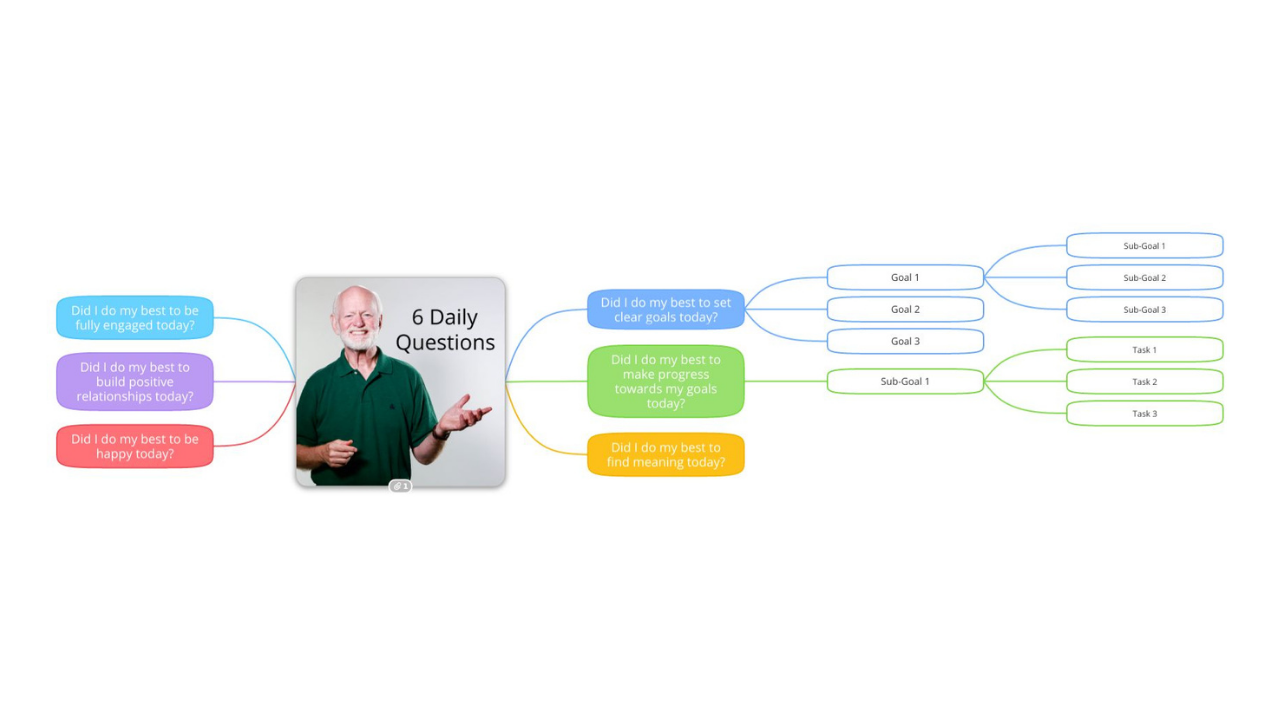6 Daily Questions template

The 6 Daily Questions template encourages you to ask yourself ‘active’ questions (rather than ‘passive’ ones), so you can reflect on what you’ve achieved each day and hold yourself accountable for your success. This template was created by the world-renowned leadership expert and coach, Dr. Marshall Goldsmith.
What is the 6 Daily Questions strategy?
The 6 Daily Questions Strategy was created to help business leaders set themselves up for success. It dictates that they should be taking the time to reflect on what they’ve achieved by asking themselves 6 ‘active’ questions each day, or asking their employees to do so. These 6 questions are related to your progress, goals and happiness, and my studies have concluded that they can lead to increased satisfaction with life.
These questions reflect the behaviors that are most important to me – and are likely to be to you, too. At the end of each day, you should be asking yourself if you did your best to…
Be fully engaged?
Build positive relationships?
Be happy?
Set clear goals?
Make progress towards my goals?
Find meaning?
These 6 Daily Questions form part of the daily question process that I personally use to ensure that I’m maintaining my focus and keeping what’s most important to me firmly in my mind. Each day, I will challenge myself by answering 32 questions that represent the behaviors I know are important but are easy to neglect. However, the 6 Daily Questions strategy was born following a conversation with my daughter, Kelly Goldsmith.
Kelly, who has a Ph.D. in behavioral marketing, explained to me that companies often rely on passive questions in surveys asking about their employees’ engagement. ‘Passive’ questions are those that describe a static condition. As an example, “do you have clear goals?” is a passive question because it can cause people to think of what is being done to them, rather than what they are doing for themselves (such as ‘having bad managers’. These should be turned into ‘active’ questions that focus on your own actions, such as “Did you do your best to set clear goals for yourself?”
Following our conversation, I reworked the first 6 of my 32 questions into the ‘active’ ones that are included in this strategy.
Why should you use the 6 Daily Questions strategy?
The 6 Daily Questions strategy is a great tool for self-reflection. By asking yourself these same questions each day, you can stay motivated to achieve your goals by keeping at the forefront of your mind. By using ‘active’ questions (that focus on your actions) rather than ‘passive’ ones (that focus on the actions of others), you can also hold yourself accountable for your success, which can also give your motivation a boost. This is because active questions will challenge you to describe or defend a course of action.
Another benefit of asking yourself these 6 Daily Questions is that they can help you maintain a more positive mindset by focusing on your success. In fact, in my research involving over 2,500 people, I have concluded that answering these questions can lead to increased life satisfaction.
How to use the 6 Daily Questions template
My 6 Daily Questions template is set out into the format of a colorful mind map to encourage you to think creatively – so you can generate the most impactful answers to each question and allow for better self-reflection. Discover how to use my template below.
To access the template, sign up to Ayoa. Once you've signed up, navigate to the homepage to create a new whiteboard, mind map or task board and choose this template from the library.
In the first box (or ‘branch’ of the mind map), ask yourself: ‘did I do my best to be fully engaged today?” To add your answer to the template, hover over the box and click the green arrow next to it to add a new connected branch. Then type your answer in the box that appears. Feel free to add as many branches as you need!
Do the same for the following questions: ‘did I do my best to build positive relationships today?’, ‘did I do my best to be happy today?’ and ‘did I do my best to find meaning today?’. Again, add new connected branches to each question to add your answers to the template.
Now it’s time to ask yourself, ‘did I do my best to set clear goals today?’ Using the sub-branches we’ve created for you (titled ‘goal 1’, ‘goal 2’ and ‘goal 3’), add a brief overview of your main goals to the mind map. Then use the ‘sub-goal’ branches to break these goals down into smaller, more specific steps.
Finally, it’s time to reflect on whether you’re staying focused on your goals. Ask yourself, ‘did I do my best to make progress towards my goals today?’ Add your sub-goals as branches, then use additional connecting branches to define what actions you took to work towards that goal each day.
Repeat this process the following day!